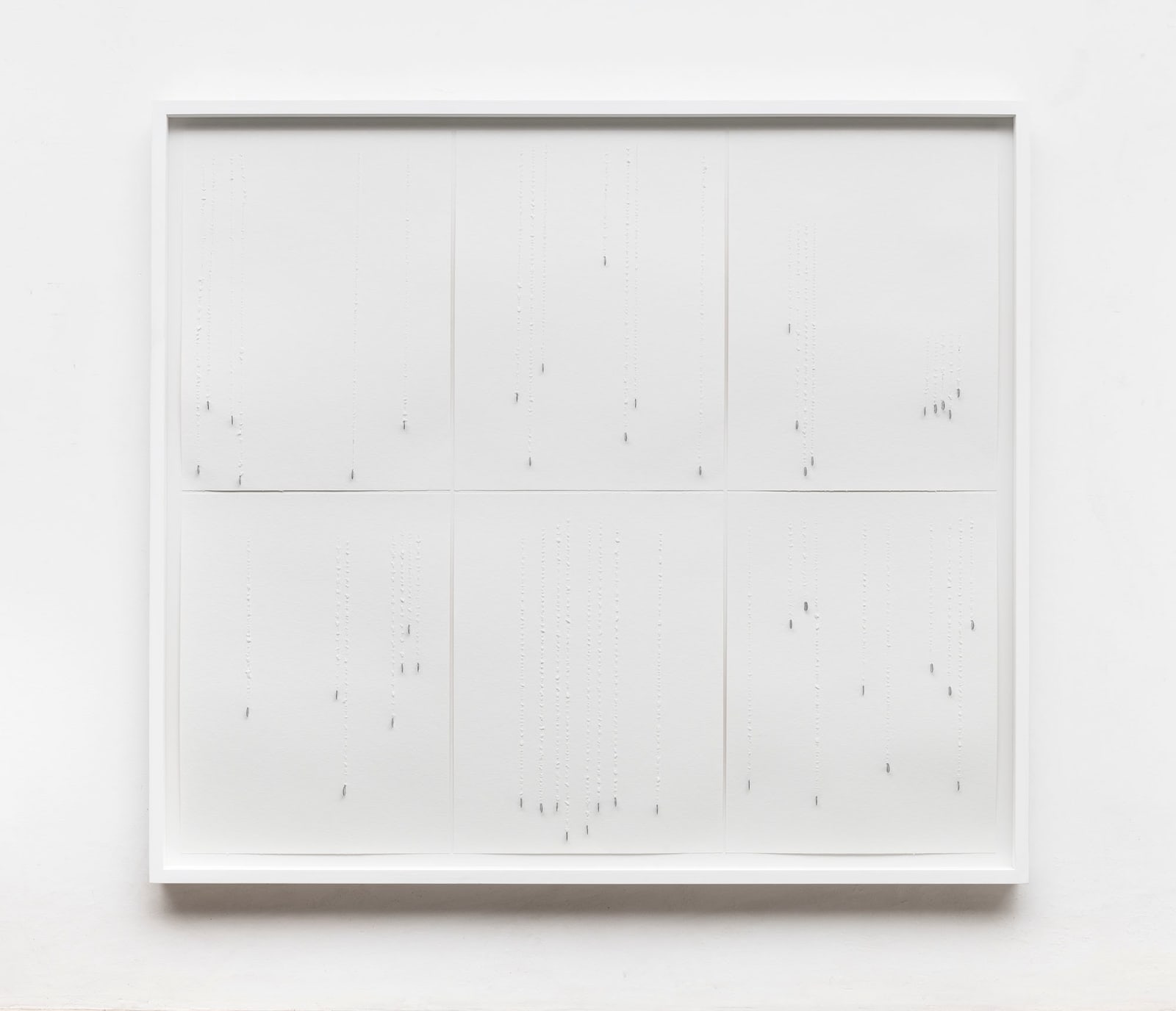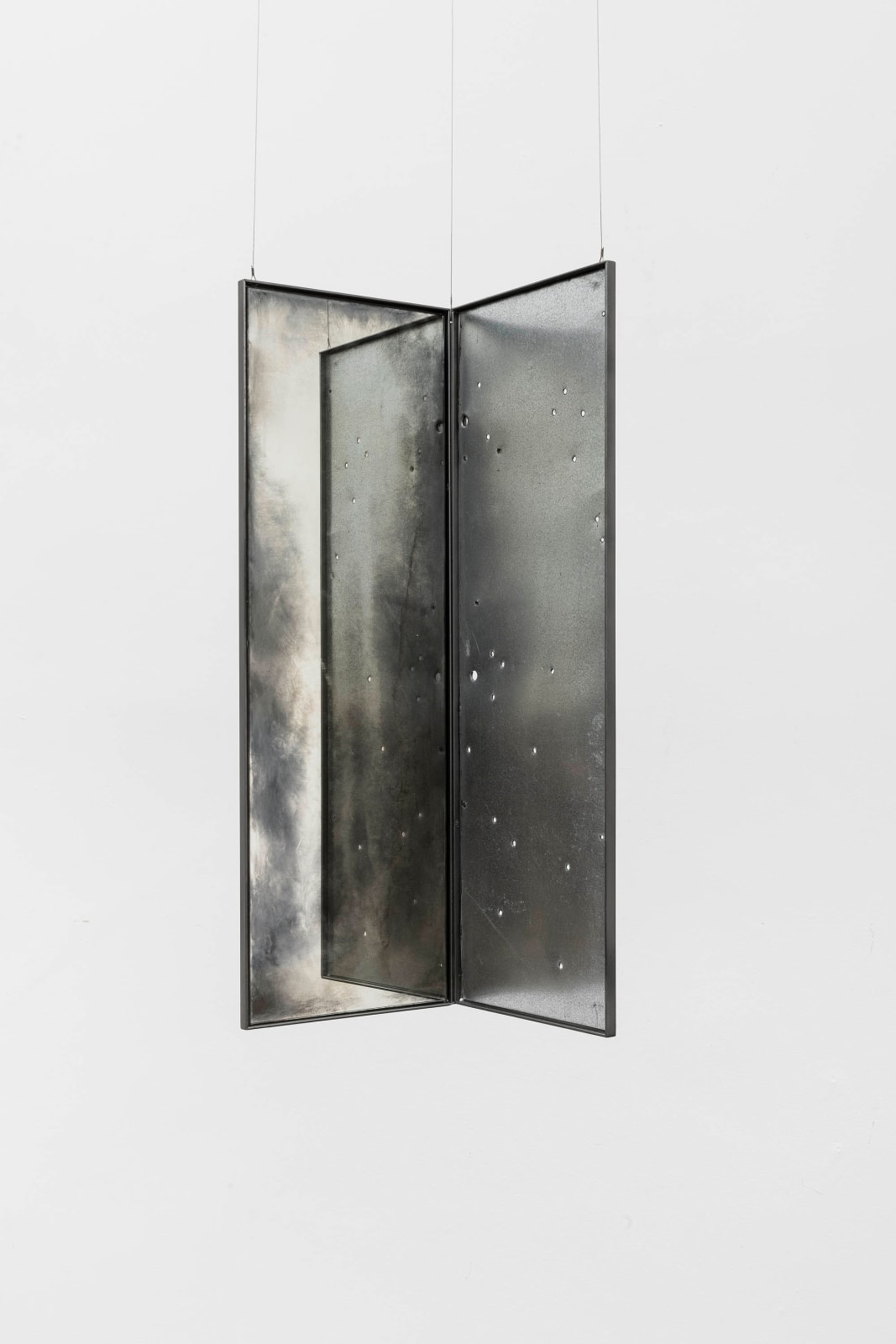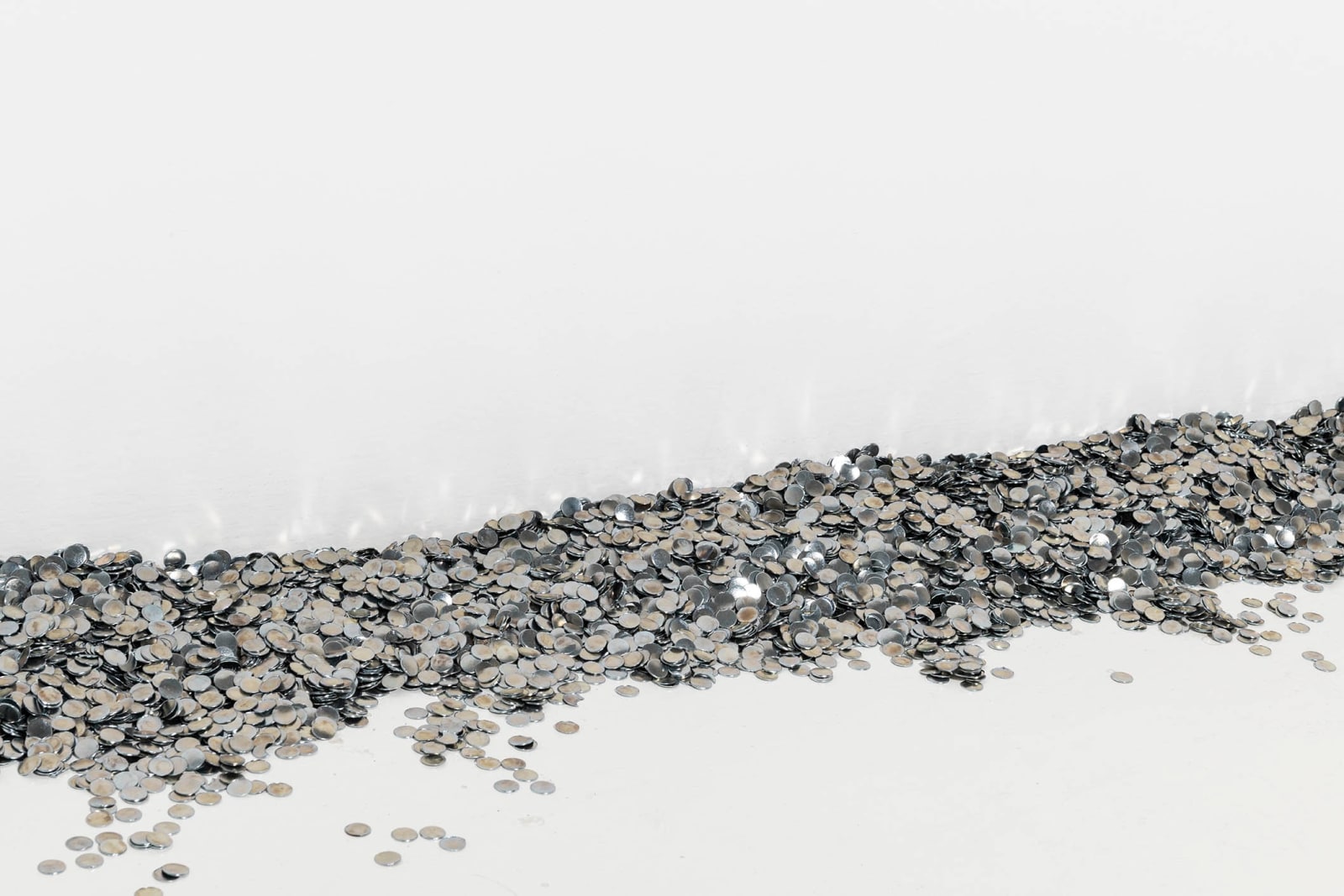holes of light in the sky ---------------------- early signs of time[1]
Awah Jeguakaih Rendah*
I wanted to see Carolina’s work that looks like a light sky made of heavy metal. – some nocturnal stars emerge from that plate during the day, a constellation I cannot identify. it must be a new one that astronomers don’t know about; they have given a name to the Capricorn Constellation, perhaps we could call this one the Cordeiro (Lamb) Constellation --- even though this name implies a gentle appearance, there are too many whirlwinds and storms inside this sky made of a zinc sheet. – Carolina, I have seen her since time immemorial, unfolded into a rose that carries strong, pointed thorns of protection, yet exuding a sweet scent that reaches far distances, also bearing the beautiful natural shape of an almost heart-like love. ----------------
over there, in the depths of the room, some stars appear to have fallen from the sky or cast themselves down as a cosmological, scientific [anthropological?] experience __ I don’t know! It’s possible that these are the things of gods and goddesses we have yet to know. Is Time a God, or is Time a Goddess? Godx, disregarding human genders and unfolding other linguistic attempts at description: Tempus / Tiempo / Temps / Tan / Timp / Time / Taimi / Tíma / Tid / Tyd / Tiid / Tijd / Tɛm / Ntango / Temps / aravo / Temp.[2]
_is it Carnival? It seems to me that this profane celebration with origins lost in time has just taken place, perhaps the she-Christ has descended to unwind, a truce with his older brother, the three wise men also came, shedding their royal attire and joining the people in an ode to freedom.------------------------------------------------------
_or did the ore train derail at some point between the Gold Mines and the state of Espírito Santo? it is quite certain that any body that approaches this moving cargo will be adorned with gleaming dots like a starry sky or a Carnival day.--- ----------------------------------------------------------------------------------------
_still in time: is Carolina promoting a pagan celebration or protesting against the hidden dams about to break with their toxic sludge that threatens our water reservoir? --------------------------------------------------------------------------------
and what about this image that multiplies narcissistically? _there, it positioned itself there, within a fold of the world like in a fold of time _it is raw yet crafted, it is in the distant past, but metallurgy shapes its future, an announcement of the future --- it seems to me that it was just the other day that an African president announced that foreign companies should use raw materials on African soil thus opposing the export of still-virgin resources, setting in motion a change in the process we endure for the exploitation of mines and lands.-----------
.it seems that the zinc coins tear through the paper much like machines tear through the earth: mining has in some way forged this art of the mines that came from Africa through the hands of the Bantu and later Nago people: blacksmiths, artists, craftsmen, poets in general carry this nostalgia for iron; they use iron dust in ceramics; they embed nails in their wooden sculptures; they forge metal and weld whenever possible; at other times they write lengthy texts and recite oxidized poems or draw with iron dust on cotton paper sourced from German or French factories. --- Carolina uses the zinc of Brazilian popular music, of the shacks from Mangueira and Providência in the 1900s. --- she also uses time and certain poems from Itabira, a mining land.
-- and if everything that was said were to be taken away? there would be no need to write this text; zinc would not have been exploited; perhaps the forests of the Watu valley would still be preserved and a linguistic world would remain there--- but this is another world, a mythical place that exists far from here, distant from this time.--- in this place there is no Cordeiro as we know her, nor is there a Rosa flower, not even the thorns that Rosa might use for protection – in this world where everything that was said has been stripped away, zinc remains untouched beneath the earth and the existing thorns might belong to the xique-xique cactus that has another name. --- nothing was said; zinc remains underground, diluted between the earth and other minerals; the water remains pure, with a taste that changes with every note of mineral in the soil, sometimes gold / sometimes bauxite / sometimes zinc / the diamond only allows itself to be washed but doesn’t imbue the water with its flavor. ---- when stars fall here, they leave the water with a faint taste of meteorite.--- there are no museums – buildings to store stones and the archive is the very world that renews itself with each monumental change in climate, a time nearly imperceptible compared to the time it takes for the dams holding toxic mining waste to rupture.--------------
_the confetti scattered across the room’s floor or nestled beneath/above the paper occasionally remind me of coins ----_the confetti seem to me like coins clandestinely minted in the hills shortly after Vila Rica, when the mines still paid their share[3] to the King of Portugal --- there was one or many instances when the coins were minted in the forest,_ the colonial law prohibited minting houses in the colony – only gold bars were legally smelted, the coins had to bear the mark of the overseas kingdom,---- at times, the markings on the confetti appear violent to me, hinting at bruises or scars left by the colony. --- perhaps Carolina wasn’t seeking the poetry of the material present in the paper, yet this can also provoke the skin & flesh ._and in my eyes, scars leap ---.
extra-world machine ---------------------- remove everything that was said about time
_all of this work seems to be a time machine / world machine / extra-world machine, matter moves through time and space, traversing distinct lives and common lives ::::: lives connected by the exploration of matter on one side and its manipulation on the other.---------------------
metal spans centuries, traveling across Europe from Transylvania to Israel in today’s Middle East.--- it is zinc that creates the covering protecting other metals, such as steel and iron, from oxidation and corrosion; it is the sacrificial metal, like the sacrificial cow that is thrown into a river first during a treacherous crossing filled with piranhas, so that the others can cross safely; zinc is the one that will oxidize, so that the others can remain intact. --- it is also zinc that is used to replace old toxic asbestos tiles, lining some anti-ultraviolet ray umbrellas [solar radiation protection] and even being added to sunscreens and tanning lotions, mixing it with carrot and avocado pulp, forming a perfect barrier against the sun’s radiation. –---- we hardly know it, but that metal sheet lying there, those fallen zinc confetti on the ground like a post-Carnival scene, is also a body; its elements pass through our body and those of our contemporaries and extra-temporaries --- yes, it seems that the formation of life remains heavily reliant on the element zinc, which plays a role in protein and nucleic acid metabolism --- there are some old folks like my father who used to suck on zinc nails or chew/lick small zinc coin-like plates because, as they said, the metal helped with potency and semen production. _the old man would say that a soup made from quail eggs, yam, and a few peanuts cooked in a zinc pot or with a zinc sheet at the bottom helped enhance desire and consequently increase the chance of offspring --- my mother would say that the responsibility for expanding the family doesn’t rest solely on the men, who wouldn’t hesitate to use zinc candies to boost their virility; she would then add that green papaya milk oxidizes zinc and prevents a lack of desire. --- the grandmother, my mother’s adoptive mother, would say that a zinc blade can heal wounds and even restore the hymen of a non-virgin woman who slept with a man before marriage.---------
and the older old woman also used to say that the flavor of food becomes stronger when cooked in a zinc pot, and even the smell of meat becomes larger.--- and the mother of the mother also used to say that the so-called zinc leaf also nurtures a woman’s desire and fertilizes the awakening body. --- and the mother used to say that desire has to arise from both sides, even during Carnival, if you want to expand the family, both the man and the woman have to eat together from the same zinc plate, _. if the intention is a small family, with just one, two, or three blossoms, then eating papaya must be done by hand, without a spoon or fork, even if they are not made of zinc.
.-- and the machine blends time between the Carnival with the zinc confetti at the bottom of the bedroom-living room and the love of mother & daughter, woman & man, man & man, woman & woman; it fuses the time of yesterday & today and the flower that will blossom tomorrow beneath the starry sky on the zinc sheet at noon and the scars-scabs on the cotton paper – bamboo . ---
-------------
scars, keloids and scabs ------------------------------------ under a starry sky
._Scar was the nickname of the one who lived in the central square, performing juggling and other tricks with his body in the 1980s---_ he lived, in those years, crisscrossing the country in every direction the Wind Rose could take him._ I never learned his given name .– he died later, before the end of the last millennium, – he didn’t die from the iron and zinc nails he stuck in his nostrils, but rather from being poisoned by the food and gasses released from the hot zinc pot in which he cooked beans with pig ears and trotters, wherever he moved and set up camp.------------------------------ _my mother used to say that zinc is beautiful, but it kills, whether it is a knife or a pot, a glass, a jar, or a plate.--- she used to say that zinc gives potency and fertilizes the prostate and the womb, but it has to be zinc that comes from the meat of beef, goat, lamb, catfish, tilapia, tambaqui, pirarucu, aracu, pacu and black beans, chickpeas, lentils, peanuts. – she used to say that papaya milk kept in a zinc container corrodes the metal and poisons human beings. – My mother whispered in my ear: _if you are going to use a zinc sheet, it is better to use it as roof to cover a house made of mud walls! – she also said: _listen to those who have already died, the fish dies through its mouth, caught by a metal!---- and so it was that I witnessed the bamboo paper torn and marked by keloids due to the zinc coins.—every coin has two sides: it is good to know with what and with whom you go out during Carnival: Exu, Osiris, Bacchus, Dionisius, Hathor Goddess of love, beauty, joy, drunkenness, music, fertility, Oxum, Saint Gonçalo, Saint Onofre. ----
._my mother said that nobody needs to suck on a zinc nail or cook beans in a pot of the same material to have a child, experience pleasure, or find love. – my mother said that the best thing is to be able to eat good food, which already contains all the necessary minerals [ iron, zinc ] that the body needs in the right balance = a lack of zinc does not prevent anyone from being born, but an excess of zinc leads to certain death, leaving no time left for the last rites._ The “Carnival” of the zinc confetti, the groover of the “scar” on the paper, the “narcissus“ at the corner of Carolina’s[4] fold of time tell us a lot and evoke memories, making us think of many other things.
-------------------------------------------
-- note to read carolina ---------------------------------------------------------
_for reading and experiencing Carolina, I suggest listening to good music and reading good poetry, before, during, or after, among many others: “O Tempo” by Carlos Drummond de Andrade / “Para Sempre” by Carlos Drummond de Andrade / “Nosso Tempo” by Carlos Drummond de Andrade / “O tempo” by Mario Quintana / “Tempo Só [Time will tell]” ( pop, 2002) by Gilberto Gil / “Oração ao Tempo” (MPB, 1979) by Caetano Veloso / “Tempo Feliz” (samba, 1965) by Vinicius de Moraes & Baden Powell / “Sobre o Tempo” (pop, 1995) by John Ulhôa / “O Tempo Não Para” (rock, 1988) by Cazuza & Arnaldo Brandão / “Novo Tempo” (MPB, 1980) by Ivan Lins & Vítor Martins / “Tempo Rei” (MPB, 1984) by Gilberto Gil / “Tempo Perdido” (rock, 1986) by Renato Russo / “Resposta ao Tempo” (bossa nova, 1998) by Aldir Blanc & Cristóvão Bastos / “Templo do Tempo” (MPB, 2015) by Flaira Ferro & Igor Bruno / “Tempo da Estiagem” (samba, 2020) by Raphael Vidigal & Ronaldo Ferreira ...
_______________________________________________
*Paulo Nazareth / Paulo da Silva / Awah Jeguakaih Rendah
is a craftsman, a collector of spells, and an apprentice of strong prayers born in
Nak Borun / Watu Valley – Central Pindorama
[1] [Translator’s Note] The author possesses a unique stylistic approach to Portuguese that involves the manipulation of spelling norms. In the translation, I have not attempted to recreate solutions that mirror his way of reinventing words. The English version adheres to conventional writing style, as the author’s distortions are specific to the Portuguese language.
[2] --- Latin, Spanish, French, Haitian Creole, Romanian, English, Samoan, Icelandic, Swedish, Afrikaner, Frisian, Dutch, Krio, Lingala, Catalan, Guarani, Corsican
[3]--- during the colonial period, any free white man who discovered gold in the “royal” lands was obligated to pay a fifth (quinto) of their findings to the Portuguese Kingdom. This process took place in the so-called Royal Smelting Houses situated on the colonized land, where the gold was melted down to create bars stamped with the mark of the Portuguese Crown. --- One fifth of the total metal was collected by the houses and sent back to the metropolis. While coins were prohibited, some clandestine mints appeared covertly in the mountains of the Captaincy of São Paulo & Minas de Ouro, which later became the Province of Minas Gerais (separated from the Province of São Paulo), now known as the State of Minas Gerais.
3 Carolina is the name of a rose [Carolina rose] from the East Coast of North America, specifically from what is now the state of South Carolina, United States. It spreads along the entire coast up to Canada. --- it is the kind that is considered a pioneer species, one of the first to arrive during forest growth and it tends to tolerate all types of soil and different pH conditions. – Caroline rose has straight thorns resembling needles, setting it apart from other flowering plants that typically have curved thorns. _when the sun comes out, Carolina emits its fragrance. Carolina is the mother of Rosa, and both lambs (Cordeiros) have their thorns.







